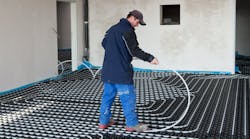Latest from Hydronics & Radiant
Sponsored
Incorporating Hydronic Heating into Sustainable Building Design
Sustainability is a crucial consideration for any new project. People are more aware of climate issues and environmental regulations are rising. In light of this shift, sustainable building design will become increasingly in demand over the next few years.
Hydronic heating professionals are in an advantageous position ahead of this trend. Hydronic systems are inherently more eco-friendly than conventional alternatives. That said, a few practices can take these environmental benefits even further.
Here are seven ways to optimize hydronic heating systems for maximum sustainability.
1. Right-Size the System
Sustainability begins before construction, though these earlier opportunities are easier to overlook. System size may not seem relevant to a building’s sustainability, but it significantly affects energy efficiency.
If a hydronic heater is too large for a property, it’ll likely short-cycle, consuming more energy than necessary. On the other side of the spectrum, smaller systems must run for longer to reach desired temperatures, introducing excess power withdrawals.
Unfortunately, most domestic boilers don’t operate optimally, leading to energy waste at either extreme. While performance optimization is a complex consideration, it starts with choosing an appropriately sized boiler and distribution system for the project at hand.
2. Use High-Efficiency Heat Sources
Heat sources are another important factor in sustainable hydronic systems. A high-efficiency water heater will maximize hydronic solutions’ energy-saving benefits. Upcoming legislation may require many heaters to achieve 91% efficiency, making this selection easier, but there are many ways to go about it.
The most straightforward option is to opt for EnergyStar-certified water heaters. However, looking outside the boundaries of traditional power sources may yield more impressive results.
As counterintuitive as it seems, many gas-heating solutions produce fewer emissions than electric ones, as most electricity comes from fossil fuels. Electrification opens the door to zero-emissions power through renewables. Powering water heaters through on-site solar will produce the most environmental benefits.
3. Ensure Proper Insulation
Even the most efficient heat source will still consume more energy than necessary without proper insulation. Hydronic heating systems radiate heat by design, so this consideration can be difficult. The building must have enough insulation to prevent heat loss but not so much that radiant heating can’t work.
The key is insulating everything that isn’t supposed to radiate heat. Radiators and radiant floors must be able to let high temperatures transfer, but virtually everything else requires thorough insulation. That includes walls, pipes, ceilings and any non-radiant parts of the floor.
The kind of insulation contractors use matters, too. The EPA maintains a list of eco-friendly insulation standards to look for when choosing a material. Many of these use renewable or recycled materials to minimize their carbon footprint.
4. Combine Energy-Saving Technologies
Hydronic heating professionals should also work closely with other involved contractors to combine sustainability efforts. These solutions’ efficiency benefits are most significant when the building’s other systems don’t lead to excess heat loss or energy waste.
Windows are responsible for 30% of heat loss in buildings, so they deserve special attention. Using more insulated window panes is a good start, but contractors can minimize this loss through add-ons, too. Thicker blinds, curtains, automatic shutters and plastic window insulation wraps can all help.
Doors are another area to tackle to minimize heat loss. Electrical systems also demand attention, as any inefficiencies here will reflect in the hydronic solution’s operation.
5. Utilize Zoning Controls
Contractors should also take advantage of hydronic systems’ unique additional features—namely, zoned heating. Zoning controls let building occupants heat different areas of the home to different levels. As a result, it’s easier to strike an ideal balance between comfort and energy consumption.
Hydronic systems can implement zoning in one of two main ways. First, contractors could design entirely separate systems for each area in the home. Second—and more cost-effectively—they can place zoning valves between areas and connect the system to a smart control system to let occupants adjust each zone from one place.
These systems are more expensive than simpler alternatives. However, energy-efficient systems save money in the long run by reducing power spending. Focusing on these long-term benefits will help buildings retain their desirability even at higher prices.
6. Optimize Distribution Systems for Efficiency
Similarly, hydronic professionals should consider how their systems distribute heat. While radiant heating as a whole is more eco-friendly than other temperature control methods, not all radiant systems offer equal distribution efficiency.
One of the easiest ways to ensure efficient water movement is to use shorter pipes. Longer pipes and more fittings will mean less internal pressure, requiring more energy to distribute liquid through the system. By contrast, smaller pipes will increase pressure to preserve power.
Newer, more energy-efficient pumps are another way to optimize distribution. Some projects have reduced their power consumption by 60% by simply upgrading pumps. Many of these more recent options can deliver the same power with smaller motors, creating energy savings significant enough to account for their upfront costs.
7. Consider Future Maintenance Needs
Finally, contractors should consider the system’s maintenance. Sustainability is often a long-term game and ongoing energy savings are only possible if equipment remains in top condition. Consequently, hydronic heating systems should be easy to monitor and maintain.
Designing for simplicity is an important part of achieving this goal. A less complex system will be less prone to failure and easier to fix if something does go wrong. Similarly, buildings should hold key components like water heaters and pumps in accessible locations for faster inspections and repairs.
IoT is a potential game-changer in this area. IoT sensors can monitor hydronic systems and report their condition in real-time, alerting occupants or contractors when something requires attention. While more expensive, these systems will save money over time by preventing costly breakdowns.
Hydronic Heating Is a Natural Fit for Sustainable Design
As sustainable building design grows more popular, so will hydronic heating. Professionals looking to take advantage of this trend should learn how their projects can offer even more environmental benefits than standard hydronic solutions.
Oscar Collins is the Editor-in-Chief at Modded. Follow him on Twitter @TModded for frequent updates on his work.


